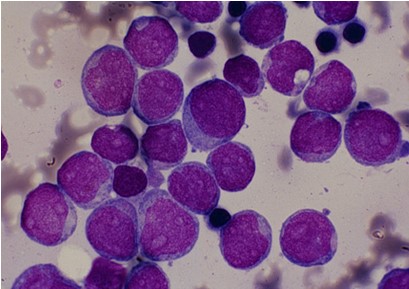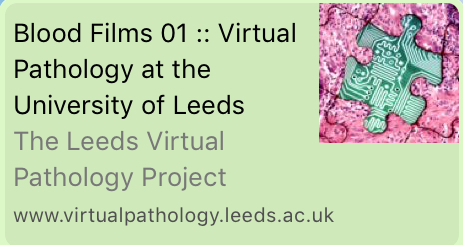FRCPath exam information and resources
"Possession of FRCPath in Haematology by examination is a mandatory requirement for the award of a CCT in Haematology."
The Royal College of Pathologists
But don't let this put you off a career as a haematologist!

Yes, it is another exam to revise for, pay for and sit; but it also uniquely allows haematology to span both the diagnostic and treatment aspects of medicine. Morphology will always play an important role in clinical haematology, even as specialist haeamtopathology units continue to expand. As a clinical haematologist you will still need to be able to quickly recognise haematological emergencies, such as acute promyelocytic leukaemia, leucostasis or thrombotic thrombocytopenic purpura from blood film appearances if a patient presents out-of-hours.
The knowledge and skills required to pass the FRCPath exam are the same as those required to practise confidently as a consultant haematologist in the future. In order to help you gain the necessary skills, all your 5-year (if undertaken full time) specialty training is haematology-based - you are not required to take part in the acute unselected general medical take, unlike trainees in many other medical specialties. In addition, other medical specialties also now have exit exams - Specialty Certificate Examinations - prior to being awarded a CCT.
What does the FRCPath exam involve?
FRCPath exam is taken in two parts. Part 1 is usually undertaken after at least 18 months' of registrar training and is a one-day exam consisting of two separate 3-hour papers: an essay paper and an MCQ/EMQ paper. Candidates must pass both papers in order to obtain a pass in the FRCPath Part 1 examination. More detailed information about the exam can be found on the Royal College of Pathologists website (click here).

Part 2 can be undertaken once a trainee has obtained a pass mark in Part 1 but it is usually attempted after 3 years' of training (i.e. during ST6). It is a 3-day exam comprising 4 papers and an oral examination. There are short and long morphology cases, coagulation and transfusion written papers, and two 30-minute vivas. Click here for further information from the Royal College of Pathologists website.
This exam takes place over a day. In the morning there are four essay questions, one each on malignant haematology, general haematology (the non-malignant conditions), coagulation disorders and blood transfusion. Then in the afternoon, there are multiple choice questions and extended match questions on all four areas.
It is a long day, and there may not be any access to food, so make sure you take plenty of supplies.
The examiners want to know that you are a safe haematologist capable of being a registrar. It is very clinically orientated and your day to day work will help with passing the exam. That said, you do need to study as well, and this will help you in your job, so it’s a win all around.
You do need to pass this exam before you can progress into ST6.
This is the exam you need to pass to be a Consultant Haematologist, and it is longer and more in depth than the part 1 exam. However, as with the part 1, there has been a big push to make it more clinically relevant, less laboratory driven, and therefore candidates seem to be more likely to pass.
Unfortunately, you will need to take a microscope with you for the exam. The department you are working in at the time should lend you one of theirs; you do not need to buy one. You can add it temporarily onto your home insurance. Your department may have a case, otherwise transportation methods include a large suitcase with towels, boxes and bubble wrap, and bags and duvets. If you are travelling by train, the microscope can be stored in the guard’s van. Make sure you take oil, tissues and a spare bulb with you just in case.
The exam itself is over three days. Day one is morphology. You will have some time in the morning to set up your microscope, and then in the afternoon there are up to 12 short cases over 90 minutes and three long cases at half an hour each. Currently there are more candidates than slide sets, so they are shared out: half the short cases at a time and then swap in the middle, and 30 minutes per long case then swap.
Day two consists of two short answer question written papers, one on transfusion and one on coagulation. The third day is viva day - four 15 minute slots, again on malignant, non-malignant, transfusion and coagulation topics.
When you are preparing for this exam, make the most of your colleagues and consultants. We all want you to pass, and there are a variety of slide collections and question papers out there which people are willing to share. Do not be afraid to ask the consultants to mark your papers and to give morphology teaching, it is very helpful. Practice is key; even if you do not want anyone to look at practice papers, make sure you do at least one or two so you can get the timing right.
The following advice is from registrars who have taken the exam in recent years:
Some people find it helpful to have a 'study buddy' to quiz each other on guidelines, immunophenotyping, morphology etc; other trainees learn more effectively if they study alone. People will give you lots of advice with opinions divided as to which works best. In the end either is fine, have the confidence to stick with a revision style that suits you.
Know your guidelines really well, especially any new or recently updated guidelines.
Practise looking at as many differnt blood films, aspirates and trephines as you can. The UK NEQAS salide collection in your local lab is really good for this as there is a wide range of different morphology, including things you might not see on a regular basis e.g. parasites and some of the rarer haemoglobinopathies. The explanations that accompany the NEQAS reports are also really useful learning tools (and will also give you confidence if you got the correct diagnosis!).
A lot of my colleagues found practice vivas with consultants really helpful. I didn't want to do this. Neither option is better than the other - again, it just comes down to what you think will help you feel most confident in the exam itself.
Some of the consultants will have slide sets and accompanying questions. These can be really good exam practice for the morphology exam, especially the short cases. Ask around to see if anyone has any slide collections - many do - and if you can borrow them. Try to do them under exam conditions.
I found the Practical Haemostasis website invaluable for all the clotting stuff - especially for laboratory coag. The website has a lot of questions to help consolidate and test your understanding too.
Practising essay questions was really helpful. The FRCPath website has a few sample questions but often if you ask consultants they are happy to give you an essay title and mark your work afterwards. Also there's often a goodie bag of previous trainees' mock exam questions and answers, a resource that builds up over time as more trainees go through. It can be really helpful to have a go at the exam questions and then mark your own exam using the previously marked answers from past trainees.
Writing essays was a really good way to learn as well as to practise exam technique. To start with I really couldn't answer the questions so used the mock essay titles as a way to really gauge what I knew, what I thought I knew but evidently did not, and how well I understood it. This helped me hone down what I needed to revise and then, closer to the exam, I could see that my ability to answer the essay questions had significantly improved. This gave me a bit of confidence for the exam too.
The NHSBT transfusion revision course was ideal for my transfusion revision. It covered all the areas I needed to know/ revise and I did not need to do too much additional transfusion revision outside the course.
FRCPath practice papers (part 1 and 2) - small collection of examples of past papers from the Rpyal College of Pathologists website. Includes MCQs, EMQs and essay questions from part 1 and part 2 exams.
British Society of Haematology guidelines - compulsory reading material for exams and for day-to-day clinical practice, these guidelines are your best friends. Read them, understand them, and know the recommendations in bold. The examiners have a sneaky habit of asking about guidelines that are coming out, so keep your ears close to the ground for upcoming ones, and make sure you have a good knowledge of recent guidelines. Be aware that some of the guidelines may be a few years old and due for review.
British Society for Haematology educational resources - morphology image bank, case reports, practice essay questions, EMQs, MCQs and tutorials. Signup and login required but you don’t need to be a member to make use of the BSH’s question bank of essay questions, MCQs and EMQs. Make sure you practice your essays in advance of the exam - most of us haven’t written one since school and it takes a bit of time to get back into the swing of things. This, along with the BSH guidelines, is probably the most useful resource in terms of getting you ready for the exam.
Blood Journal "How I treat..." articles - easy-to-read helpful overviews of most haematological conditions. Usually include a section on the patholphysiology, case examples and available treatments. It must be remembered that these are American articles so some of the treatment strategies in particular are not necessarily the same as in the UK.
United Kingdom Haemophilia Centres Doctors' Organisation - information and guidelines on the investigation and management of patients with inherited bleeding disorders.
Prognostic scoring systems - online prognostic scoring systems for many haematological diseases.
www.ihaematology.com - revision site for FRCPath exams created by previous candidates.
www.practical-haemostasis.com - an excellent site - though rather dry - for all things coagulation-related, particularly with regard to the laboratory tests. Explanations of coagulation assays, practice questions, clinical implications.
Royal College of Obstetricians and Gynaecologists Greentop Guidelines - guidelines on the management of haematological conditions (e.g. sickle cell disease, VTE) in pregnancy.
Haembase - a general revision resource for those preparing for FRCPath examinations.
Online digital morphology - an expanding collection of blood films and marrow aspirates with answers housed on the Leeds University Virtual Pathology website.
FRCPath Part 1
The Essential Transfusion Medicine (booked via http://hospital.blood.co.uk/training/clinical-courses/) is a week long course which you should ideally aim to go on in ST3, but definitely before the exam. The Intermediate Transfusion Medicine is done later on, usually during your secondment to transfusion, and therefore may be before part 1 or between the exams depending on the timing of the attachment. These transfusion course are a mandatory part of your haematology training.
Vishal’s part 1 course has been found helpful by some trainees.
You will receive a lot of well-intentioned advice regarding which course you should or should not attend. Don't feel you must go on a lot of exam-related courses if you do not find such courses helpful to your learning style. Some people work best left alone with a textbook; other people prefer the structure and guidance they can receive on a course. The key is to learn in a way that works for you.
FRCPath Part 2
Manchester coagulation course or UCL coagulation course
Intermediate Transfusion Medicine (usually done during your transfusion placement, but can be done before part 1 or part 2) and FRCPath transfusion revision course. Both booked via http://hospital.blood.co.uk/training/clinical-courses/
Oxford obstetric haematology course
Vishal’s part 2 revision course
Current morphology collection contains 3 sets of 12 blood films and bone marrow aspirates in FRCPath short case exam style. Describe each film and give a diagnosis then check your answer. Useful for part 2 exam practice but also for learning purposes.
Link to FRCPath-style morphology cases
Further more general morphology collections also housed on the Virtual Pathology website.
Link to Virtual Pathology website
Link to LearnHaem website (external link with FRCPath-style morphology cases)
Teaching sessions are recorded so that they can be viewed at a later date. You should receive the link to access these as part of the programme that is sent out prior to each teaching day but if you do not have access please contact haematology.regional.teaching@gmail.com
